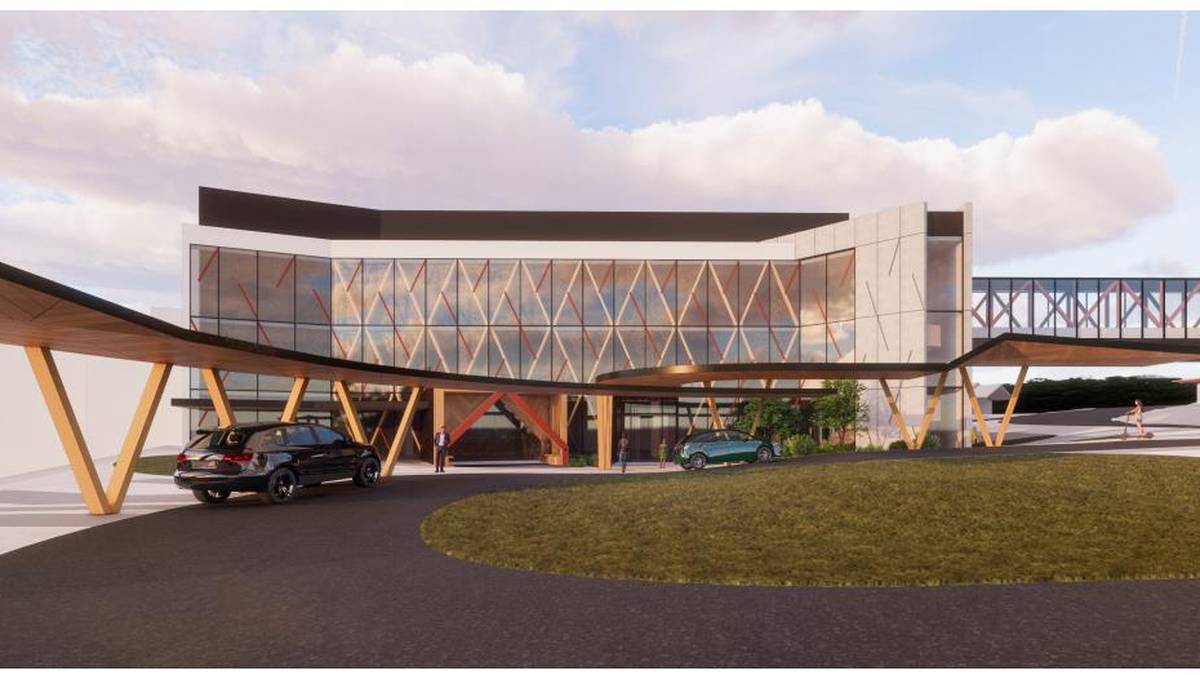An artist’s impression of the proposed new Whangārei hospital development Photo / Te Whatu Ora Te Tai Tokerau
Northland District Health Board petitioned the Government for a $944 million rebuild of the run-down Whangārei Hospital, but $711m was proposed instead.
National Health Spokesman and Whangārei-based list MP Dr Shane Reti says this will
see the new hospital at capacity when it opens.
However, Health Minister Andrew Little said the Government is committed to building a fit-for-purpose hospital in Whangārei as part of its wider rebuild of the public hospital system.
Little said no decisions about the design of the hospital have yet been finalised, and when they are, they will be made by the Ministers of Health and Finance.
In May the Government set aside $572 million for the new hospital in Budget 2021 and further funding has been reserved in the Budget once the Northland District Health Board (NDHB) submitted a business case for the extra work needed for the ageing hospital.
The Northern Advocate has received a series of documents dated from May to August this year relating to Project Pihi Kaha, the redevelopment of Whangārei Hospital.
They include a briefing paper to the Capital Works Steering Committee dated May 24, the Assurance Report to the Te Whatu Ora Board dated August 17 and the detailed business case report to Te Whatu Ora from August 25.
/cloudfront-ap-southeast-2.images.arcpublishing.com/nzme/WNAVE7QNI2ZDKRJNRVVHZ6GR4I.jpg)
It is clear from the Assurance Report to Te Whatu Ora Board that the detailed business case recommended rebuild Option 3, a $944m redevelopment of the hospital, but acknowledged that this was currently unaffordable for the Government.
It, therefore, proposed to split the funding by approving Option 2A at a cost of $759m, with the balance of funding required to deliver option 3 by 2024.
However, the detailed business case noted that on its own Option 2A would not meet the investment objectives and delivers poorer value for money than Option 3.
The briefing paper to the steering group noted that the recommended Option 3, with a cost of $917m will remain NDHB’s preferred option.
This was rejected by the committee and an amendment was sought for the business case to ensure an option meets the signalled reserved funding of $711m.
This work is now under way and amendments are being made to Option 2A (acute services building only) to meet budget expectations.
An Advocate source said that in order to meet the budget expectations, which are $200m below what NDHB preferred, it would mean a reduction of up to 128 beds, meaning when built the hospital would be at or near capacity.
The source said that Option 2A would in effect only give around 20 new beds above what the hospital’s current capacity is.
This would appear to defeat the object of building a new hospital to future-proof the service for the region if it is already at, or close to, capacity when built.
The briefing paper says that the Ministry of Health has indicated that Health NZ would be able to make a submission for additional funding to deliver the scope of Option 3.
And if the additional funding is not approved, the redevelopment would not meet the investment objectives or deliver value for money in terms of the project benefits.
Whangārei Hospital has been in a poor state for years – in 2021 sewage was leaking down the inside of walls in the hospital’s medical wing.
The unwelcome discharge was among a raft of infrastructure woes that included roofs that leak in heavy rain, windows falling off the surgical wing, and lifts that have broken down with bedridden patients inside.
Little said he had yet to receive any advice on the design of the new hospital.
/cloudfront-ap-southeast-2.images.arcpublishing.com/nzme/TUYXFIN4MV7A7OATVCBBRJEA2A.jpg)
”There is usually a negotiation process between local health officials and capital investment officials, which is why local health officials express their recommendations on their preferences.
In the decision-making process to date, capital investment officials have not reduced the funding envelope (originally $570 million); they have increased it (currently $711 million), but final decisions have not yet been made,” he said.
Building new hospitals is a massive project and takes time. The Government currently has $7 billion committed to health infrastructure, including the new Whangārei Hospital.
Every infrastructure project in the country is facing potentially major cost escalations because of supply-chain issues, the war in Ukraine and global inflation pressures. In the health sector, I’ve asked all project leaders to look at appropriate steps to mitigate the risk of cost escalation.
”This Government inherited a massive catch-up job. Over nine years, the previous Government spent $1.3 billion on infrastructure, including two years (2015 and 2016) when it spent no money on infrastructure at all.
“That’s why our hospital buildings got so run down. In just five years, we have committed $7 billion to new infrastructure, including the new Whangārei Hospital.”
However, Reti said it is disappointing that the proposed Whangārei Hospital upgrade is slowly being downgraded, and with a potential start date of 2026 and a four-year build it is possible the hospital will be near capacity when it is completed.
/cloudfront-ap-southeast-2.images.arcpublishing.com/nzme/BFNA4EVRFQLGWS3TEAFZAML26I.jpg)
”On current proposals, the new build will only add 20 extra beds. The documents confirm that it was a National government in 2015 that started the redevelopment process,” he said.
Reti said half of the $486m funding for bureaucratic health reforms would have allowed Whangārei Hospital to have its preferred redevelopment option.
He could not commit, at this stage, to National fully funding the $944m preferred hospital.
”National is not privileged to the current operations of the capital investment committee or the funding envelope that will be available next year for capital projects, Labour may have spent it all, however, we are aware that Whangārei, Nelson and Dunedin hospitals are well advanced for redevelopment.”




